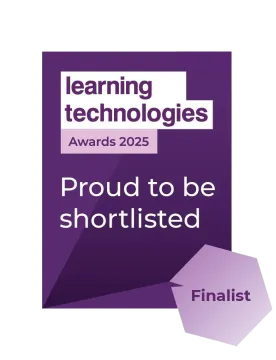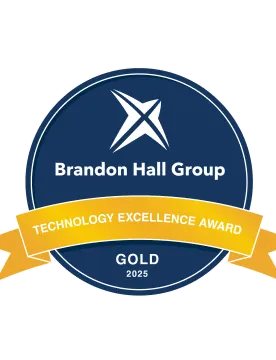Our traditional approach to live learning programs has typically involved 90-120 minute presentations. But we couldn’t rely on programs like this because of the challenges of hybrid work and remote learning. We found that it's harder to keep people engaged and focused in a virtual setting, with all the distractions of working from home. To address this, we have introduced microlearning with 7taps.
“7taps has been an incredible tool for creating compelling microlearning materials in a really short time.”
Watch Samantha Tripp sharing her microlearning best practices at MicrolearningCONF.
Using microlearning to energize remote training
Let's consider a real-life situation. My job was to turn a 90-minute training for new managers and those who had just been promoted into a series of "microlearnings."
Here’s the strategy that helped me break down complex topics into smaller, digestible chunks while maintaining a clear flow and ensuring that the modules build upon each other:
1. Identify the most important subcategories in your existing training content.
When you think you've broken down a training as much as you can, take another look. This will make sure that the microlearning is as snackable as possible. The subcategories will become your mini-courses.
Example: In my case, these subcategories included topics such as: interviewing, one-on-ones, accountability, providing care and attention,recognizing achievements, giving feedback, communicating expectations clearly, fostering the growth of individuals, power skills, and coaching.
2. State the learning goal for each subcategory.
A good rule of thumb here is to think about you sending an email to a friend. You don't have to do a long intro, you just get right down to business.
Example: If we talk about interviewing, what they need to learn is how to identify the skills needed to interview a potential new hire. By using a concrete action word like "identify" instead of a word like "understand," it prevents the concept from being abstract. This will make it easier for you to measure success at the end of the microlearning.

3. Enable your audience to personalize their microlearning journey.
When developing a microlearning program, it is essential to keep in mind that not all content will be relevant to every learner in your target audience. Recognizing this and providing learners with the flexibility to skip certain parts is crucial for creating an effective and engaging learning experience.
Example: If a learner is a manager who isn't currently hiring a contractor, they can skip that portion of the learning path and use their time to focus on what is most important to them.
4. Keep learners engaged and motivated with microlearning.
In a traditional long-form training, there are many ways to get learners involved with interactive activities, discussions, and simulations. However, it can be difficult to recreate this level of engagement in a microlearning format. But don't worry! With 7taps, it's easy to keep learners engaged. Take a look at this mini-course to find out more:
What benefits we see around using microlearning
For us, microlearning is a way to re-think and break down training into more digestible pieces that can be completed in just a few minutes. It also provides room for extra engagement and personalization.
- Microlearning reduces mental fatigue by allowing learners to focus on one topic at a time and then take a break to recharge.
- Learners who may not have the time for longer courses can still benefit from short microlearning modules.
- Microlearning allows us to personalize courses to meet the specific needs and interests of individual learners.
- Microlearning helps to make larger learning paths more manageable and less overwhelming by breaking them down into smaller, more digestible doses.
- Learners can quicker access the information they need, rather than having to navigate through a longer course.
💡More microlearning ideas for training
- Streamline sales enablement process
- Drive asynchronous learning
- Reinforce safety and compliance training
- Support L&D programs across the organization
- Implement four microlearning scenarios right away











